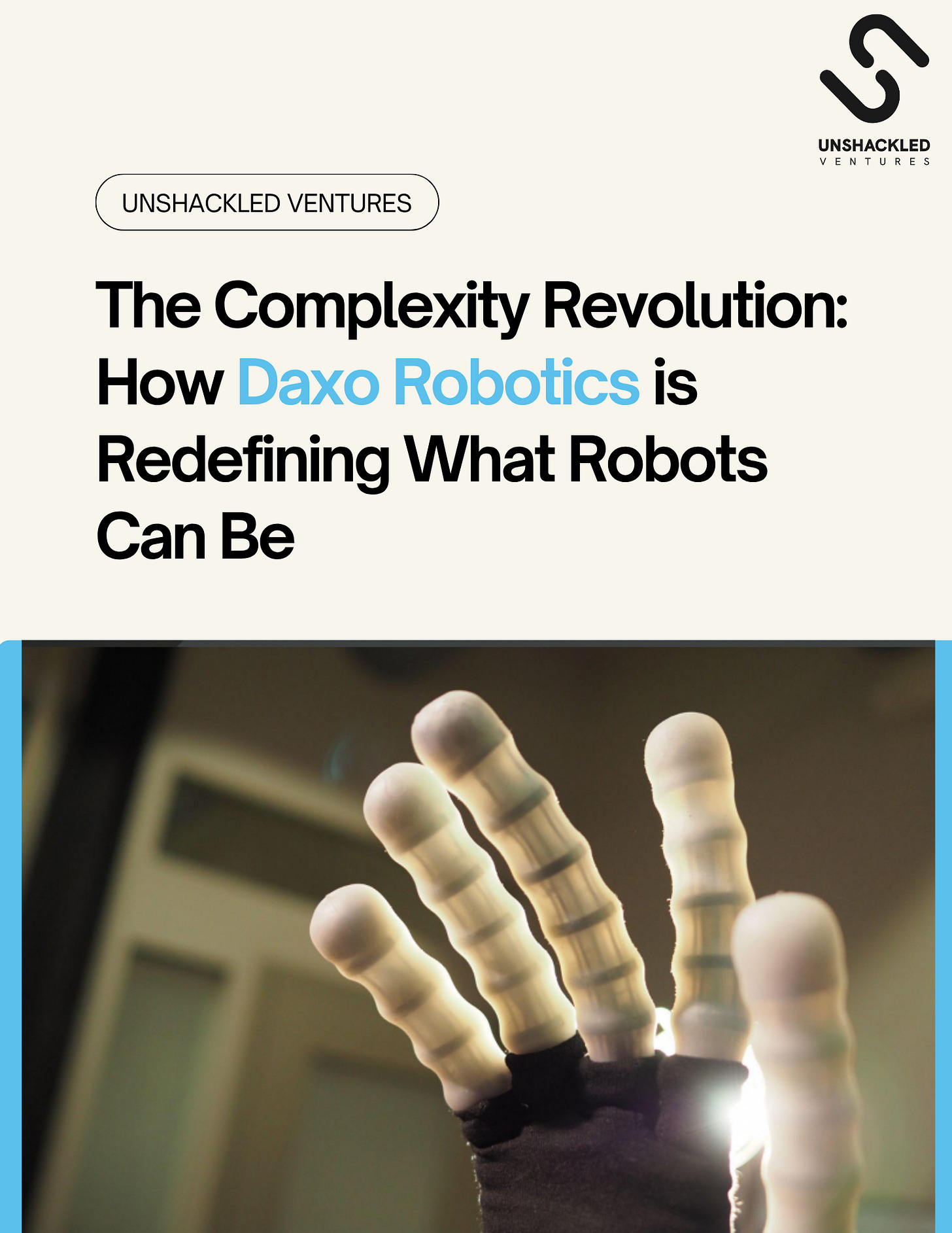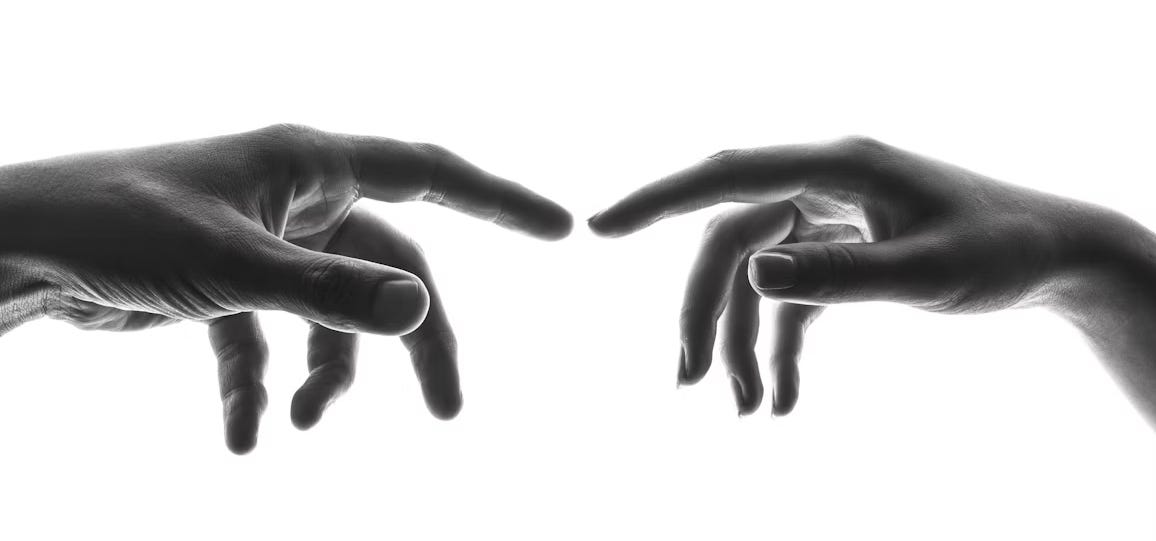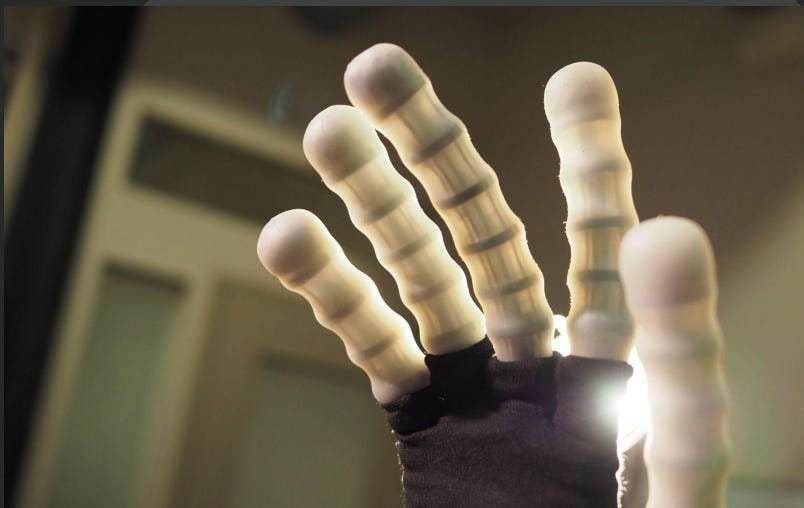The Complexity Revolution: How Daxo Robotics is Redefining What Robots Can Be
Last week, our portfolio company Daxo Robotics unveiled Muscle v0: a robotic hand powered by 108 individual actuators and designed with what they call "infinite degrees of freedom." The launch video, showing the hand performing fluid, human-like movements with incredible dexterity, quickly went viral, getting the attention of robotics researchers and enthusiasts from around the world.
But Muscle v0 is more than just another flashy prototype showing incremental advances in robotic manipulation. It's a fundamental philosophical challenge to how the robotics industry has approached dexterity for the past five decades. While the entire field has been obsessed with making robots simpler, more precise, and more predictable, Daxo has taken the opposite approach: embracing complexity and backing it up with breakthrough engineering.
From my first meeting with Tom Zhang, Founder of Daxo, it was clear he wasn’t just building another robotics company, he was challenging the assumptions the entire field is built on. Asking a crucial fundamental question:
What if robotics hasn’t hit a wall because of poor execution, but because it’s been climbing the wrong mountain altogether?
The Industry's Wrong Turn
For decades, the dominant approach in robotics has been clear: design systems to be as simple as possible while still getting the job done. That approach works well for repeatable tasks in controlled environments. But when it comes to dexterity, adaptability, and real-time problem-solving (the kind of work humans do naturally) robots still fall short.
The irony is that in trying to keep robots simple, engineers often end up making them overcomplicated. To solve dexterous tasks with limited actuators, they patch solution after solution. Adding sensors, complex algorithms, and workarounds until the system becomes a maze of interdependent fixes.
The Daxo team understood that this isn't a failure of technology or execution, it's a failure of philosophy. The industry's obsession with simplification has created what Daxo calls a "complexity ceiling" that prevents robots from achieving true dexterity. Traditional robotic hands typically have 15-25 degrees of freedom, modeled loosely after human joints. This seems logical, if humans can manipulate objects with 27 degrees of freedom, surely robots can do the same with similar or fewer.
But this reasoning misses a crucial insight that the Daxo team has built their entire company around:
Human dexterity doesn't come from the number of joints, but from the incredible complexity of the muscular and nervous systems that control those joints.
This mismatch has created a "long tail" problem in automation. Most automation has tackled the easy 20%, the structured, repetitive tasks. But the messy 80%, where dexterity, variation, and context matter, remains largely untouched. And that’s where Daxo is aiming.
The Daxo Philosophy: Complexity as Intelligence
Rather than accepting the complexity ceiling as unchangeable, Daxo asked a different question: What if complexity isn't the enemy of reliability, but the source of adaptability?
Muscle v0 is a physical embodiment of that idea. Instead of minimizing actuators, Daxo built more of them. Each finger contains 20 actuators, forming what they call “ultra-redundant muscle arrays.” Not because every task needs that many, but because having more options unlocks entirely new capabilities.
And that’s the key, Muscle v0 is complex by design, but not complicated. It’s built from many identical components working in parallel, without patches, hacks, or fragile interdependencies.
This redundancy gives the system space to discover solutions, not just execute pre-programmed ones. When something unexpected happens, the hand can dynamically explore actuator combinations until it finds what works, something traditional robotic hands simply can’t do.
Even the way Daxo thinks about failure is different. Most engineers try to eliminate it entirely. Daxo designed for graceful degradation - systems that continue functioning even when components fail. In Muscle v0, losing 10% of actuators often doesn't reduce performance at all, because remaining actuators compensate through different activation patterns. That resilience mirrors how human bodies operate, if a muscle is injured, others step up.
This approach mirrors biological systems, where redundancy and adaptability are the norm. Human muscles work in groups; if one is injured, others compensate. Daxo has applied this principle to create machines inherently more resilient than traditional counterparts.
And when you pair that kind of hardware with modern AI, systems trained to operate in high-dimensional, real-time environments, you get not just a robotic hand, but a platform for intelligent manipulation.
Led By a Technical Visionary
Tom’s story reflects the kind of founder we’re drawn to at Unshackled - deeply technical, relentlessly curious, and unafraid to go against the grain.
He was raised in rural China, growing up in caves in a small agricultural town, later moving to Singapore for high school, where he first discovered robotics. That interest brought him to the U.S. to study mechanical engineering and computer science at Cornell, where he took a gap year to intern at iRobot, Uber, and Rapyuta Robotics. He came out of those experiences with clarity - he wanted to build something he could fully own.
Tom moved to Philadelphia to pursue a PhD at UPenn, focusing on machine learning for robotics. That’s where we met him - already forming the early insights that would become Daxo.
Why This Matters
Muscle v0 is a working prototype, but more importantly, it’s proof of a different way of thinking. It shows that complexity (when designed intentionally) can lead to systems that are more capable, more robust, and more adaptable than the existing options.
That’s the kind of thinking we look for at Unshackled. Tom didn’t just follow convention, he questioned it. He saw what others dismissed as unnecessary complexity and turned it into an engine for progress.
Daxo’s journey is still just beginning. They’re building not just better hardware, but a new paradigm for what robotic systems can become.
Incredibly proud to be on this journey with them.
— Unshackled Ventures
Immigrants Start Here.
About Unshackled Ventures: Unshackled Ventures is the only early-stage venture capital fund that enables unrecognized and excluded immigrant founders to start companies in the U.S. Since its founding in 2014, Unshackled has proven its thesis that investing and supporting this population drives strong investment returns across key industries, including American infrastructure, generative AI, healthcare, space, and enterprise SaaS. To date, the firm has invested in over 100 companies and over 250 entrepreneurs.






